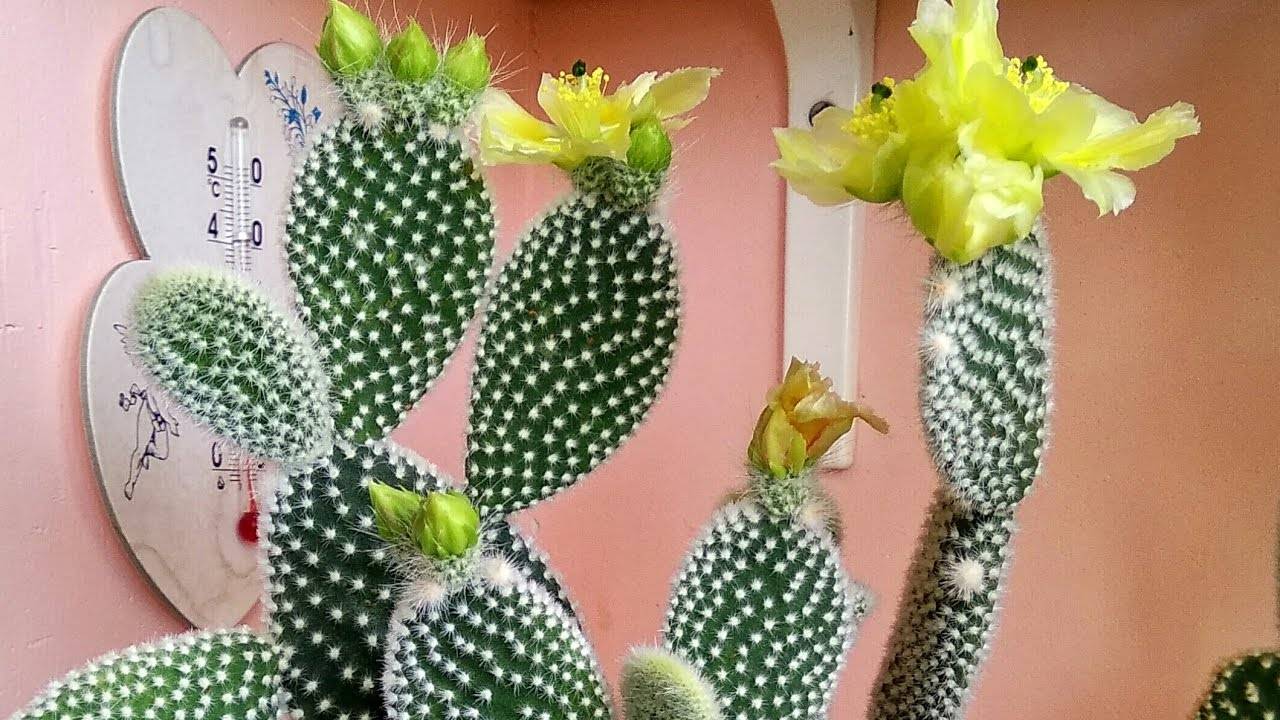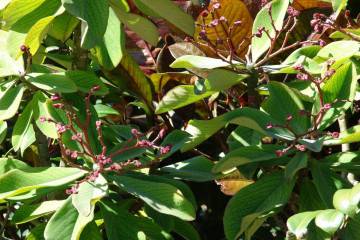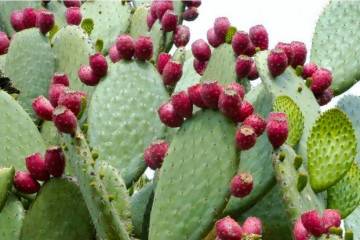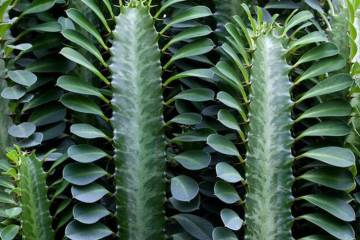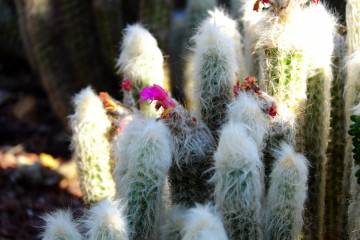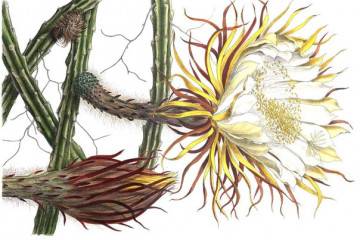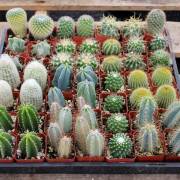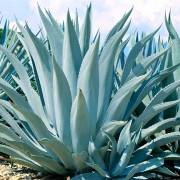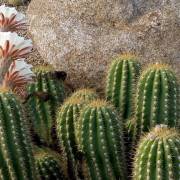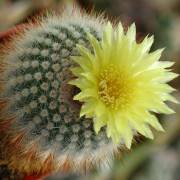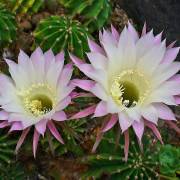Opuntia cactus - varieties, home care
Content:
Opuntia is a cactus that has a rather unusual and quirky appearance. A succulent plant is not at all capricious in its care, but there are certain nuances in its cultivation. At home, it has a fairly compact size, but in its natural environment it can grow to huge dimensions.
What does prickly pear cactus look like?
What is prickly pear? The plant cactus opuntia, which has not only an unusual appearance, but also a name, belongs to the Cactus family. Under indoor conditions, it does not grow more than 50-70 cm.
Opuntia consists of large fleshy shoots; varieties growing in the form of a tree are rare. Shoots can grow straight, or they can creep along the ground. The leaf plates are also fleshy with a convex surface. Glochidia are located on the shoots - these are the buds of a succulent, from which thorns later appear.
Common varieties
The plant is subdivided into many varieties, there are more than 350 varieties. The most common and popular among gardeners are:
- Common prickly pear is a classic variety growing up to 4 m. It dissolves yellow flowers;
- Brazilian prickly pear is one of the largest types of succulents. It has the shape of a tree, in its natural environment it grows up to 20 m, but in artificial cultivation, of course, it has smaller dimensions. The flower got its name in honor of the homeland of growth;
- prickly pear Subulata. It differs from other varieties in a thick stem with cylindrical and needle-like leaf plates on it. Despite the thorn-shaped segments, the cactus itself is considered thornless;
- The prickly pear is cylindrical. Outwardly, it resembles the previous variety Subulata. It has branched shoots on which needle-like segments are located. There are thorns at the ends of these segments. Flowers are yellow, red, orange with greenish blotches;
- Berger's prickly pear is a cactus that grows as a shrub. It has many branched processes;
- Opuntia Microdasis is considered to be the most beautiful type of cacti. Its most characteristic feature is the location of snow-white thorns over the entire surface of the plant. The inflorescences have a pale yellow tint. This species is better known as prickly prickly pear;
- Opuntia Monacanta is a compact plant. The appearance resembles a coral. It is very much in demand in home floriculture.
Features of home care
During cultivation, many nuances should be taken into account.
Temperature
Opuntia does not suffer when the temperature drops in summer, but you should not do it abruptly. Sudden changes adversely affect the health of the flower. The optimum growing temperature during the active growth period is 18-25 ° C. With the onset of winter, the temperature is gradually lowered to 6 ° C.
Lighting
The cactus is not particularly picky about light, but you should not put the pot in direct sunlight.The fleshy and large leaf plates of the bush can be damaged and burned.
Watering
High-quality care for prickly pear cactus at home is especially dependent on watering. The soil under the succulents should not dry out, but be constantly moist. On hot days, the amount of watering is increased, and with the arrival of cool days, on the contrary, it is reduced.
For irrigation, use soft and slightly acidic water. To acidify it, you need to add a few drops of lemon juice or a pinch of citric acid to it.
Spraying
The plant does not need spraying. However, this procedure will help large sheet plates to be cleaned of dust and dirt, since due to the presence of thorns it is impossible to wipe them by hand with a rag.
Humidity
Succulent plant tolerates droughts well and is not particularly capricious to low air humidity.
Priming
Succulents are not picky about the soil, so it is enough to keep it loose and moist. To increase the air permeability of the soil, you need to mix the soil with river sand, fine brick chips or other drainage material.
Top dressing
Top dressing is carried out with a period of 3 weeks. It is recommended to purchase complex mineral preparations intended for cacti. During flowering, you need to lower the nitrogen content in the fertilizer, and the potassium content, on the contrary, increase.
Features of winter care during the rest period
If the cactus was grown on the balcony, it is necessary to bring it into the house with the arrival of autumn. In no case should temperature fluctuations be allowed. In winter, prickly pear goes into a dormant state, so the temperature is slowly lowered to 6 ° C. Top dressing and watering should be reduced.
When and how it blooms
Opuntia is a cactus that does not have a particularly bright and abundant flowering, but it is not so easy to achieve it either.
Types of flowers
The inflorescences are single, on which there is one flower. After flowering, green prickly pear fruits begin to form in place of the bud. After a certain time, they acquire a dark red hue.
Flower shapes
Regardless of the type of prickly pear, the flowers have a similar structure. Located on the tops of the shoots, they can have a different color: white, yellow, orange, red. Many elongated petals are arranged in several rows, due to which they form large flowers.
Flowering period
The succulent plant begins to bloom in mid-spring. The buds stop forming only in late summer or early autumn.
How prickly pear cactus reproduces
The succulent plant is propagated vegetatively, that is, using cuttings. This requires an adult prickly pear, from which a stalk is cut from a strong and healthy shoot. Then this trim is left overnight at room temperature so that it has time to dry thoroughly. During this time, a kind of film appears on the surface of the cutting.
The cutting is deepened into a dry substrate for succulents. You should not often water the ground after it has rooted, it is better to cover the container with film or glass.
Transfer
It is extremely rare to transplant a cactus, since the prickly pear adapts to new conditions for a very long time. Good reasons for transplanting a plant are:
- active growth in the first years of life;
- cramped pot;
- disease or appearance of pests;
- reproduction of the bush.
A third of a substrate of loose earth, humus and river sand with small pebbles is poured into a new container. A cactus is transplanted there and covered with the remaining earthen mixture. After planting, the flower pot is placed in a dark room for two weeks.
Possible growing problems and diseases
Due to improper care of prickly pears, diseases and pests can appear. Some problems can be noticed and cured at the initial stages. However, there are diseases that are almost invisible in the early stages of manifestation. Such ailments, as a rule, lead to the complete destruction of the plant.
Pests
Mealybugs, scale insects and aphids deliver big problems and harm to the flower. They are located on dense segments of the bush and suck out its juices. Insects are fought by treating the plant with insecticides. However, in the initial stages, it is enough to use folk methods, such as soap solution or potassium permanganate.
Diseases
Often, prickly pears develop stem rot, due to which dark brown spots appear on the shoots. To save the flower, it is necessary to remove the affected areas. The soil must also be disinfected, for this it is treated with a mixture of carbendazim.
Signs and superstitions
It is believed that cacti tend to reduce the negative magnetic effects of household electrical appliances. This contributed to the emergence of the generally accepted sign that the purchase of prickly pears in the house is able to protect households from the surrounding negativity. The plant can not only protect the psychological state of the owner from negative emotions, but also protect the house from thieves or burglars. Moreover, the succulent is a protector against damage and evil eye, which is sent by envious people and ill-wishers.
In addition to positive signs, there are also negative superstitions. It is believed that prickly pear in the house is able to force men to leave marriage or love relationships. Therefore, giving this cactus is a bad omen that can offend a person. "Opuntia is a flower of lovebirds", this is how this plant is also called.
Opuntia is a beautiful decorative succulent, some varieties of which have a very unusual and bizarre appearance. To grow a healthy and flowering plant, you need to properly care for it. If you are not afraid of negative signs and superstitions associated with a cactus, then you can safely purchase it as an indoor flower.
